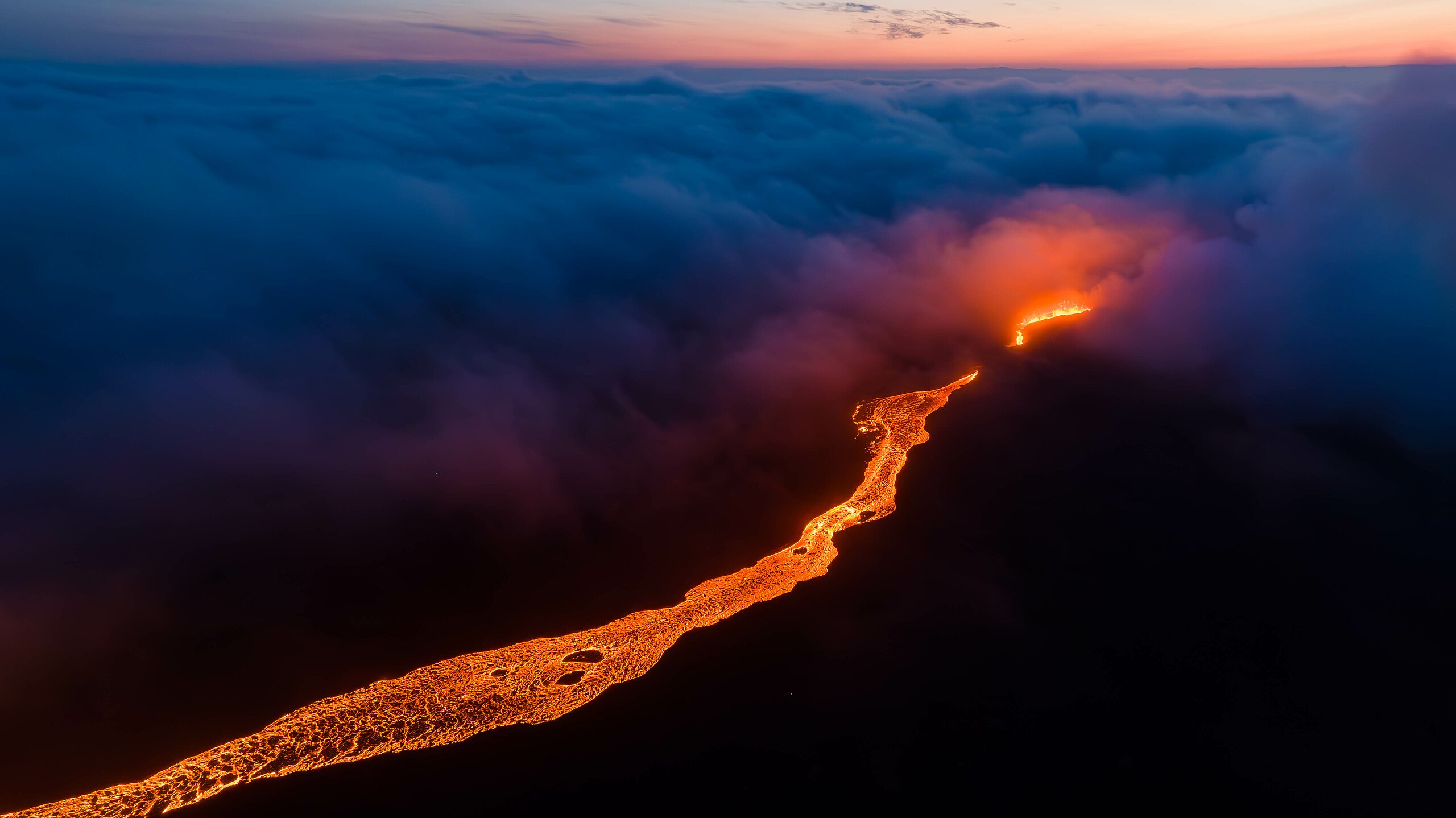Iceland Eruption Nearly Inevitable; Grindavík Could Go Under Lava

Up til now, volcanic eruptions on Iceland’s Reykjanes Peninsula were benevolent tourist attractions. They put on pretty shows and confined themselves to remote, unpopulated areas, clustered around Fagradalsfjall. No important infrastructure was harmed. People got to hike up and safely experience the birth of a new volcano. It was as good as volcanic eruptions get.
Previous Fagradalsfall Eruption Sites. Credit: Icelandic Meteorological Office
Magma started intruding under Fagradalsfjall in September, just a couple of months after the end of its third eruption. Until late October, it didn’t look like things would get too exciting. But a seismic swarm started near the Blue Lagoon area just north of Grindavík late on the 24th and ramped up dramatically overnight. Over one thousand earthquakes, the largest a M4.5, were recorded overnight, most at a depth of around 5 kilometers. By the next day, the numbers had risen to 4,000, some as shallow as 2 kilometers. And the ground was beginning to deform.
On the 27th, horizontal ground displacement was already up to 2 centimeters, and a M4.0 was recorded just 2 kilometers north of Grindavík. Yikes.
But magma hadn’t started moving on up yet.
Intrusions happen in active volcanic zones; many of them never reach the surface. They cause consternation, they rattle folks, then they fade out. A dike or sill gets emplaced with no fireworks. So while the seismicity and deformation both continued over the next few days, it didn’t mean another eruption was likely. Although quite a bit of fracturing had occurred, and those fractures could give magma an easy path up…
Then came Halloween and an “exceptionally intense” seismic swarm at Þorbjörn, right between the Blue Lagoon and Grindavík. Some of the quakes were just 1.5 kilometers deep. That’s bad news bears, my friends: you do not want volcanic earthquakes creeping toward your town and getting shallower.
By the next day, over 10,500 earthquakes had been recorded in the unrest and 5-6 centimeters of ground deformation measured. Icelandic scientists crunching the data inferred a magmatic intrusion around 4 kilometers deep just northwest of Þorbjörn. Uplift and seismicity continued. On November 6th, the Icelandic Meteorological Office announced that uplift had reached 7 centimeters and was being “caused by a sill-type intrusion” almost double the volume of previous magma intrusion events, and the inflow of magma and magmatic fluids was four times the highest rates measured during past events. Worser and worser.
That concerning state of affairs continued until the 9th, when a M4.8 earthquake hit near Þorbjörn, the largest of the swarm so far. It may not sound big, but that’s a substantial quake for a magmatic intrusion.
Things got very, very real on November 10th. A “dense earthquake swarm” started around 7 am just 2-3 kilometers northeast of Grindavík, with one M4.1 and nine quakes greater than M3. At 2 pm, there was still no indication magma was nearing the surface; at 3 pm, earthquakes had intensified at Sundhnjúkagígar around 3 kilometers northwest of Grindavík, and by evening Icelandic authorities had elevated the aviation color code to Orange and declared a Civil Protection Alert Phase.
By 8 pm, earthquakes were being measured at only 3-3.5 kilometers of the surface, and everything began to look eerily like the precursors to the 2021 eruption. The IMO announced that magma could be expected in days rather than hours, but that was cold comfort to rattled citizens.
Then the earthquakes moved south. In less than two hours, it became alarmingly clear that the intrusion, now showing itself to be a dike, had passed through the earth beneath Grindavík. Icelandic authorities didn’t hesitate: they evacuated the town. You don’t mess around when magma is that fast and shallow.
Earthquake activity diminished slightly the next day, but remained elevated, and the dike could be measured for 15 kilometers from Stóra-Skógsfell south through Grindavík to the sea.
The extent of the new 2023 dike. Credit: Icelandic Meteorological Office
Extra bad news bears, that: if the eruption occurs underwater, there will be explosions and ash and LAZE.
By the evening of the 11th, the intrusion had reached a scant 800 meters below the surface, and the likelihood of a submarine eruption increased. Despite the danger, some residents were escorted back on the 12th to quickly retrieve pets and livestock and essential items. The famous kelandic horses were also being transported away from danger.
It may be the last time anyone sees portions of Grindavík; as I was writing this on the night of November 12th, I got a notification from Volcano Discovery that a meter-deep graben had split the town just above the intrusion. It’s a sign that when magma arrives at the surface, it will be flowing within the streets and demolishing buildings.
Within hours, or days, the aerial view of Grindavík could be radically, grimly different.
Aerial view of Grindavík. Credit: Olga Ernst
Thankfully, people and most domesticated animals are safe. This won’t be a fun, adventurous, benign eruption like the last. Despite everything Icelandic folks have learned about protecting infrastructure and diverting lava flows, there’s basically nothing you can do but flee when the volcano emerges in the middle of town. The tourists who were evacuated from the Blue Lagoon may be the last humans to ever see it. But: Iceland will survive what’s coming They’ve had over 1,500 years to learn how to cope with their extraordinary, explosive island. And in the end, they’ll find new possibilities in the wake of disaster.
Gangi þér vel, Grindavík.

Rosetta Stones and Dana Hunter’s Unconformity wouldn’t be possible without you! If you like my content, there are many ways to show your support.
This website is a member of the Amazon Affiliates program. I get a small commission when you use my affiliate link to make a purchase.
Thank you so much for your support!






